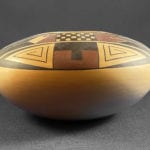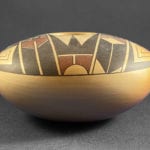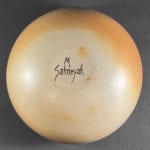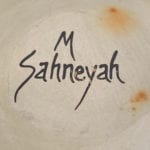This is a striking seedjar by a Tewa artist who no longer makes pottery. With study, what at first seems like a simple design of five strips of elements reveals itself as subtly complex, which explains its visual power.
The walls of the seedjar are substantial and even but not thick.; the form elegant. The slight blush on the unpainted bottom indicates an outdoor firing.
The elements of the design are sharply edged and the paint is unusually dark, evenly-applied and rich. The painting is exact and the pattern almost symmetrical. Generally I find both these traits unsatisfying, but for reasonsI have only slowly understood, here they have a particular power.
The design is in five strips across the upper surface of the pot, framed by a thin black line. The central band is narrower at the ends than the mouth of the jar it surrounds and thus increases in width at its midpoint. This forces the two flanking bands of design to also bow outwards towards the pot’s rim, these slight curves echoing the much more pronounced curve of the pot’s edge. This non-linear format adds an undercurrent of energy to the design.
The central band is centered around the moth of the jar. A sawtooth of unpainted surface consisting of two triangles flanks either side of the mouth. Surrounding this unpainted pattern is what started as a rectangle of solid black, except that this shape is residual to the central unpainted surface, the ends are narrower and the center is bowed outward around the moth and the two sides are barely connected by a thin black line. The resulting form looks most like a crown of black with three points flanking the mouth of the jar. The result is what Lydia Wycokoff calls”figure-ground reversal” so that “when you look at the pot, the figure and the background against which it is placed keep changing places, the figure becomes the background and the background becoming the figure (1985: 100-102).” This eye trick enlivens the design around the mouth.
The black design terminates with an unpainted “T.” The space below the horizontal bar of the “T” is a trapezoid with its narrow base ending with the thin black framing line. Intruding into this base is an unpainted half circle, leaving in residual two half arches that are painted solid maroon.
The second band of design is centered around an 8 by 4 checkerboard of alternative black and unpainted squares. In about 1890 Alexander Stephen, using Hopi informants, interpreted this checkered pattern was “suggesting an ideal locality, pools of water alternating with garden tracts )Patterson, 1994:245).”
The remaining designs in this band are the same for the two renditions, except that they are painted in reverse order. That is, the design to the left of the checkered square in one rendition appears to the right of the checkered section in the second rendition, the remaining elements also falling into place on opposite ends of the band.
Next to the checkered design is a solid maroon element shaped like a square with one end pushed out into a peak, like the outline of a simple roofed-house on its side. Following is a solid black space until the framing line is reached, except that it’s not this simple. The peak of the maroon roof is separated from the black section by a thin unpainted line and bisecting the black area and running more than halfway into the maroon section (through the peak) is a somewhat thicker unpainted line. Thus both the simple geometric shapes of “maroon house” and “black rectangle” are fragmented into irregular but geometric shapes that are stark and visually unfamiliar.
On the other side of the checkered center there is another “house-on-its-side” shaped area that is not as long as the similar shape already discussed. It’s internal form is unique and might be described as shaped like the number “7” painted maroon and a residual unpainted diamond form, except that one side of the diamond is intruded upon by a triangular-shaped part of the “7.” What follows is a black section like an arrow flying outward from the center of the pot, except here too the artist has visually complicated the form by placing an unpainted line from front to back and disrupting the “arrow” into two parallelograms.
Finally the outermost of the three “strips,” because of its position at the edge, takes the form of a half oval with its curve defined by the framing line. As with strip #2, the center is a square, but here divided into a black rectangular top and a maroon bottom, though the artist again has complicated matters by adding a small central black square to the top that intrudes into the maroon section, leaving the black a stubby “T” and the maroon a a thick squared “U” that fit together. Flanking this center are two unpainted triangular areas, at their center triangular greek keys with 5 turns. The residual space between the unpainted areas and the borders of the strip is a black “V” shaped form with slightly curved sides.
In short the central strip and the outer strips are symmetrical while the two renditions of the strip in between have the same designs, but with order reversed.
This detailed description of the patterns of design suggest why the pot has such strong visual impact. The paint is imposing with vivid and solid color and crisp edges. What my eye at first glance saw as a simple design of five strips is far more complex than that first look. The “strips” are not linear, but bowed. The round mouth reflects the round edge of the pot, the viewer’s eye pulled to the center by the intrigue of figure-ground reversal. The pattern of maroon color is distributed in a balanced pattern around the mouth, integrating the overall design. This round central mouth contrasts with the areas of small and large squares that flank it on subsequent bands. While the central and exterior strips are symmetrical, the two versions of strip in between have the same elements but in reverse order, keeping the viewer’s eye unsettled. The elements of design reflect Sikyatki Revival traditions, but they are modified and split into unusual shapes. Pointed elements are played off against squares. That’s a lot going on in a small space. I am beginning to understand my eye’s intrigue with this pot.
Madeline is a cousin of potter Mark Tahbo but I don’t know if Mark was also he teacher. I believe she only made pottery for about a decade,








